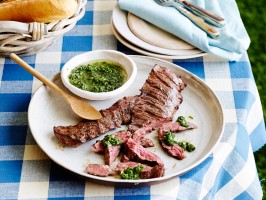There are few pleasures more primal or satisfying than the smell, sound, and taste of grilled meats, and this is the weekend to indulge the mess out of that pleasure. The idea of busting out the Weber on Memorial Day is as American as a bald eagle clutching the flag while Alan Jackson sings in the background, and barbecue certainly holds a huge place in American culinary tradition. So much so that there are regional rivalries across the country to decide who has the best style of 'que. While I am particularly inclined to represent the barbecued pork steak from my hometown of St. Louis, I am choosing not to include any American BBQ recipes in this article. There are tomes written about American barbecue, and you should read them all, but this is not the column for that. If you should want to read about the history of American barbecue, Robert Moss' "Barbecue: The History of an American Institution" gives a great historical account and the low-down on most regional differences.
Instead, I am going to take you on a little trip this long weekend and show you how people across the globe enjoy their grilled meats. The tradition of grilling is one of the oldest cooking techniques known to historians - raw meat plus fire equals dinner that won't kill you - and as such pretty much every culture worldwide has their own traditions surrounding the preparations. The grill has also always held a unique ceremonial purpose in cooking. Though it now takes the form of standing in a semi-circle around a grill waiting for the next round of brats to come off, cooking large quantities of meat over an open flame was usually reserved for times of plenty and celebration (right after a hunt, harvest time, or a holiday). Nobody is grilling one piece of meat or vegetable at a time - these preparations are all ways to serve a whole group a hearty meal without too much fuss. There's something cosmic and beautiful about global grilled meat traditions - from Indian tandoori to throwing a shrimp on the barbie down under, almost everyone on the planet has shared in the pleasure of grilling meat over a flame with loved ones around. How cool is that?!? But enough of that anthropology nonsense, this is Memorial Day weekend. So pop open a PBR, lean back, and learn how the rest of the world gets their grill on.
Lebanese Shish Tawook - recipe adapted from Mama's Lebanese Kitchen
Lebanon has been influenced by everyone that has been through it for conquest or trade. This means their food has a variety of influences, including (but not limited to) Berber, Iranian, Afghan, Indian, and Turkish cuisines. Kebabs play an integral role in Lebanese grilling tradition, and you will notice some similarities between the tandoori preparations of India and these; the most notable of these is the use of yogurt in the marinade.
2 lbs boneless, skinless chicken (breasts or thighs are fine), cut into 1" chunks
1 cup freshly squeezed lemon juice
15 cloves of garlic, crushed
6 Tbsp Greek yogurt
6 Tbsp olive oil
2 Tbsp apple cider vinegar
2 tsp white pepper
1/2 tsp ground ginger
1 tsp dried thyme
1 tsp paprika (smoked will work)
2 tsp kosher salt
1 tsp tomato paste
Mix all ingredients other than the chicken in a large bowl. Add chicken and really massage the marinade into the chicken. Let rest and marinate overnight (or at least four hours if you are in a pinch). Skewer and grill until chicken is done. Hold in a large pot with a fitted lid. This will keep the grilled chicken moist. Serve with tahini, cucumbers, pita, and grilled tomatoes and peppers.
Brazilian Churrasco Steak - recipe adapted from the Cooking Channel
For this dish you can use a skirt steak, or the more traditional picanha cut (ask your butcher, they should know...if they don't, get a new butcher). Brazilian grilling tradition is predicated on having the best of the best meat, usually beef, and grilling it hot and fast. This recipe is highly adaptable, but it hits on all the classics in Brazilian BBQ - charred, onion-y meat highlighted with a bright, herbal chimichurri.
2 # skirt steak or picanha
Freshly cracked black pepper
1 tsp onion powder
1 Tbsp white wine vinegar
1 Tbsp olive oil
4 c flat-leaf parsley
1/2 c cilantro
8 cloves garlic
3/4 c extra-virgin olive oil
1/4 c red wine vinegar
1 tsp red pepper flakes
Rub the steaks with salt, pepper, onion powder, vinegar, and the first measure of oil. Let marinate at least an hour. Make chimichurri by pulsing parsley, cilantro, and garlic in a food processor until finely chopped. Stream in olive oil and vinegar to combine. Sprinkle chili flakes, salt, and pepper in the mixture to your preference. Heat grill to medium-high. When grill is piping hot, grill the marinated steak. Both cuts will cook quickly, so be careful not to overcook. After taking it off the grill and giving the meat a couple of minutes to rest, cut the steaks and top with chimichurri.
Korean Bulgogi - recipe adapted from Maangchi
Korean barbecue is becoming more and more popular in the United States, and certainly has a foothold in Chicago's culinary traditions. While there are few replacements for going to a proper KBBQ, getting the delicious kimchi sides, and grilling while sitting, this bulgogi recipe gets pretty darn close. Serve it will rice, ramp kimchi, and a cold beer in the backyard this summer and you will hardly miss the restaurant stuff.
1 # beef tenderloin, sliced 1/8" thick (if you call ahead, most butchers will happily do this for you)
1/2 c pear juice or crushed pear
1/4 c onion, minced
4 cloves garlic, minced
1 tsp ginger, minced
2 Tbsp soy sauce
2 Tbsp brown sugar
1 tsp black pepper
1 tbs sesame oil
1 carrot, thinly sliced
Mix all ingredients other than the beef in a large bowl. If you want to save some time and some knife work, you can do all the chopping and mincing in a food processor. Add beef to the marinade. Let sit for at least an hour, but overnight would be preferable. Grill fast and hot on a grill pan, outdoor grill, or even in a skillet. Serve with rice, kimchi, and ssamjang sauce.
South African Snoek - recipe adapted from Food24
Snoek (or snook) is a very important fish in the Western Cape and southern coast of South Africa. From the finest dining options Cape Town has to offer to food stalls in informal settlements, most places have a version of the firm, white fish. I have been fortunate enough to eat snoek right out of the Indian Ocean in Hout Bay. South African's version of a barbecue is called a braai, and much like our own barbecue the customs vary by region. Inland there are more game meats (impala, beef, pork), but on the coast most grills will have at least one fish on them. This is a really tasty recipe, but more importantly it is a versatile way of cooking whole fish on the grill that will definitely serve you well this grilling season.
1 whole snoek (or another firm, white fish), head on and gutted
good sea salt
1/4 c olive oil
1 c sherry
3/4 c apricot jam
8 Tbsp butter (one stick)
2 cloves garlic, minced
1 tsp ginger, grated
1 cup of fresh parsley, loosely packed
1 orange, sliced thinly
1 lemon, sliced thinly
Season the fish inside and out with the salt and olive oil. Score the skin on both sides (two or three long lines will be sufficient). In a small saucepan heat sherry, jam, butter, garlic, ginger, and parsley until butter is foamy. Baste the snoek all over with the sauce. Arrange lemon and orange slices in the cavity of the fish. Tie the snoek up with kitchen twine. Baste once more before putting on the grill. Cook about three to five minutes on each side (the timing will depend on how hot your fire is). Re-baste the snoek on the grill. Grill for one minute more on each side or until the outside is golden and the inside is cooked. Let rest before cutting into the fish. Devour.
What are your favorite barbecue traditions? Trying anything new on the grill this Memorial Day? We want to hear from you. Comment below or send a message our way on any of our social media sites. Don't forget to tag @Foodseum and use the hashtag #FeedYourCuriosity for a chance to see your best BBQ on our feed.
Growing up in a Mexican family in the South, Rachel Valdéz started loving food before she could hold a spoon. When she eventually gained control of her motor functions, she was entrusted with tortilla duty in her grandmother’s kitchen. From then on it was near impossible to get her out of that tiny, Missouri kitchen. After graduating from Northwestern University with a degree in journalism, Rachel decided to go back into the kitchen professionally. Having just finished her culinary arts degree at Kendall College she is anxious to start work at one of Chicago’s food nonprofits to help alleviate the pressures of food access issues in Chicago. In her spare time, Rachel enjoys cuddling her puppy, haphazardly doing yoga, and writing about herself in the third person.





